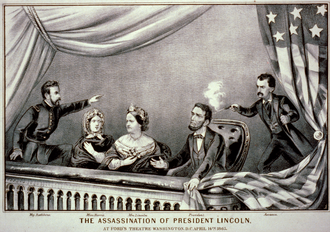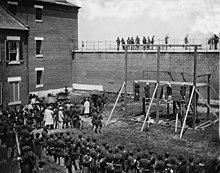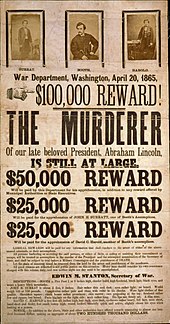Assassination attempt on Abraham Lincoln

The assassination attempt on Abraham Lincoln on the evening of April 14, 1865 was part of a conspiracy against several members of the US government and was the first attempt to assassinate a President of the United States . The assassin was actor John Wilkes Booth , a fanatical supporter of the Confederation . He shot the president in the head with a pistol during a performance at Ford's Theater in Washington , DC . Lincoln succumbed to the injury early on April 15th. Booth was killed a few days later after resisting his arrest. His co-conspirators were later sentenced to death and executed in July 1865.
background
In the spring of 1865 the United States was facing the end of the four-year civil war . After Abraham Lincoln was elected president in 1860/1861, several southern states had declared their exit from the USA and united to form the Confederate States of America . The reasons for this were considerable political and social differences, especially on the question of slavery . The efforts of the new Lincoln Republican administration to limit slavery to those states in which it already existed saw it as a threat to its economic and social base. Lincoln, in turn, viewed the secession of the southern states as a rebellion that had to be put down militarily after the Confederate attack on Union Fort Sumter in April 1861 . From autumn 1864 at the latest, a victory for the northern states in the civil war became apparent. Lincoln's re-election in November 1864 put an end to any hope in the south of achieving independence in negotiations with a Democratic government. Lincoln had always refused to negotiate Confederate sovereignty.
The final military defeat that was imminent after the surrender of the largest Confederate army under General Lee on April 9, 1865, as well as the general situation in the southern United States, aroused frustration among many citizens of these states. The complete abolition of slavery , initiated by Lincoln in the meantime , through which all still enslaved Afro-Americans were freed, met with opposition from numerous southerners, including John Wilkes Booth, who gathered a group of conspirators around him. He had met John Surratt , son of the landlady Mary Surratt , at the National Hotel on December 23, 1864 , and visited him frequently at Mary Surratt's townhouse in Washington, DC. There, Booth met with George Atzerodt , David Herold and Lewis Powell (aka Lewis Payne ). Initially, Booth planned to kidnap President Lincoln to Richmond to extort the release of prisoners of war. However, the kidnapping plan failed in March 1865. Samuel Arnold and Michael O'Laughlen left the conspiracy when it came to a prisoner exchange program. In addition, he commissioned his accomplices to assassinate other high-ranking personalities of the Union states. Both Vice President Andrew Johnson , Secretary of State William H. Seward and General Ulysses S. Grant were to be murdered.
Course of the assassination



For the evening of April 14, 1865, Lincoln and his wife Mary planned to visit Ford's Theater in Washington after the Confederates surrendered a few days earlier. Vice President Andrew Johnson was also invited, but canceled his participation. Lincoln's visit to the theater was officially announced in advance on leaflets. When Booth, who knew Ford's Theater from his acting career, found out about the President's visit, he saw the opportunity to carry out his murder plan. After Lincoln and his wife were late for the performance, they took a seat in the presidential box above the stands. They were accompanied in the box by Major Henry Rathbone and his fiancé Clara Harris. The entrance to the box was guarded by a bodyguard in the hall, outside the hall. Shortly after the President's arrival, however, the bodyguard left his post to see Our American Cousin for himself .
Around 10 p.m. local time, Booth entered the theater and approached from behind unnoticed through the unguarded entrance of Lincoln's presidential box. Booth then shot the President in the head from close range with his single-shot Deringer muzzle loading pistol . Lincoln, still alive, slumped in his chair when a commotion broke out in the hall. Booth jumped over the railing of the box directly into the hall and shouted the Latin phrase “ Sic semper tyrannis ” ( German : So always the tyrant ). However, he broke his leg while jumping into the hall. Limping and with a knife in hand, he managed to leave the theater.
An accomplice with horses was already waiting in the street. Booth and his henchman immediately fled the city. Their goal was to reach Confederation territory (the Virginia border is not far from Washington). Booth hoped to be received in a friendly and grateful manner by the southerners for his deed.
The seriously injured Lincoln was shortly thereafter taken to a bed in a neighboring building (Petersen House), where a team of doctors quickly gathered. However, given the headshot, there was little hope of saving the president's life. At 7:22 a.m. the next morning, Lincoln was no longer able to take a pulse and was pronounced dead. Lincoln was 56 years old. By now the entire Cabinet , apart from Secretary of State Seward, had gathered around the bed . Secretary of War Edwin M. Stanton was known for the saying "Now he belongs to the ages" ( German : Now he belongs to the immortals ), which he had said after Lincoln's death. That saying was later engraved in a stone in the mausoleum.
On the morning of April 15, the previous Vice President Andrew Johnson was sworn in as the new President, who ended the term of office that lasted until March 1869. The planned assassination attempt on him did not take place because George Atzerodt , whom Booth had commissioned, had shrunk in advance. The assassination attempt on General Grant did not take place either, since Grant was out of town that evening. The attack on Foreign Minister Seward, however, was carried out, but failed. Seward, who was in bed in his private apartment, was attacked with a knife by assassin Lewis Powell and seriously injured. However, his intervention was able to prevent the Foreign Minister from suffering fatal injuries.
Escape Booths and Convictions

Immediately after the attack, police units with horses and carriages were assigned to search for the attacker. A high reward of 50,000 US dollars (depending on the conversion method used, around 700,000 US dollars in today's purchasing power) was offered for Booth's capture. Booth and his accomplice managed to cross the Potomac River into Virginia by boat . Booth hoped to find refuge on the territory of the (meanwhile surrendered) Confederates. He was all the more surprised when he learned of a wave of indignation in the newspapers about the assassination attempt after he learned through the print media that Lincoln had died of his injury. In the southern states, too, his act evidently met with rejection and horror. As can be seen from Booth's diary entries, he firmly believed that he would find great recognition for his deed in the southern states. Booth also wrote that he in no way regrets the attack.

Booth and his accomplice first settled in a barn on April 26th. When the accomplice was supposed to leave this to get food, he visited a brothel and told about the attack. The prostitutes then notified the police, who were able to locate Booth's location a little later. When the injured Booth was asked to leave the barn and refused, the wooden structure was set on fire. Booth defended himself with his revolver, but was fatally wounded in an exchange of fire with the police. He died on the spot. His last words were "Useless, Useless" ( German : meaningless, meaningless ).
Booth co-conspirators were also found and sentenced to death in a military tribunal. The sentence was publicly carried out on July 7, 1865. The execution of the sentence was recorded by Lincoln's photographer Alexander Gardner in a very famous photo of the time. Mary Surratt, Lewis Powell, David Herold and George Atzerodt were sentenced to death and executed by hanging at Fort Lesley J. McNair . Edman Spangler , Michael O'Laughlen, Samuel Arnold and Samuel Mudd were imprisoned in the Fort Jefferson island fortress . John Surratt - another suspected assassin - was the only one who managed to escape. He first fled to Canada and from there to England . From England he traveled through Europe until 1867 in the Papal States was arrested and extradited to the United States. There he was tried, which ended in an acquittal. O'Laughlen died in custody in 1867. In 1869, Arnold, Mudd, and Spangler were pardoned by President Andrew Johnson .
aftermath
The assassination of President Lincoln caused a wave of horror among the American public. The events were dramatic as it was an unprecedented experience. The assassination attempt on Abraham Lincoln was the first of four presidential murders to date ( James A. Garfield was later killed in an assassination attempt in 1881, William McKinley in 1901, and John F. Kennedy in 1963). Lincoln's assassination in particular was viewed as a similar turning point to the assassination attempt on John F. Kennedy nearly a hundred years later. In addition, the so-called Lincoln-Kennedy riddle discussed what the two presidents had in common.
After his death, Lincoln was put in a coffin, which was taken on a special train to his hometown of Springfield , Illinois . The train stopped in numerous major cities such as New York and Chicago , where public memorial services were held. The ceremonies met with great public sympathy, which the print media reported in detail. Finally, on May 5, the murdered president was buried in a small circle at Oak Ridge Cemetery in Springfield.
It is widely believed that Lincoln anticipated the assassination attempt. He is said to have said goodbye to his bodyguard Crook with special words.
Literature (selection)
- Jörg Nagler : Abraham Lincoln. America's great president. A biography. CH Beck, Munich 2009. ISBN 978-3-406-58747-4 .
- Carl Sandburg : Abraham Lincoln. The life of an immortal. Paul Zsolnay, Hamburg - Vienna 1958, Heyne, Munich 1984. ISBN 3-453-55118-4 .
- Jim Bishop : The Day Lincoln Was Shot . Harper, New York, 1955. OCLC 2018636
- Andrew CA Jampoler : The Last Lincoln Conspirator: John Surratt's Flight from the Gallows . Naval Institute Press, 2008. ISBN 978-1-59114-407-6 .
- Doris Kearns Goodwin : Team of Rivals: the political genius of Abraham Lincoln . Simon and Schuster, New York, 2005. ISBN 978-0-684-82490-1 .
- Thomas M. Harris, Brig. Gen .: Rome's [ i. e. the Vatican's] Responsibility for the Assassination of Abraham Lincoln. Petersburg, Ohio: Pilgrim Brethren Press, 1989. Without ISBN.
- Michael W Kauffmann: American Brutus: John Wilkes Booth and the Lincoln Conspiracies . Random House, New York, 2004. ISBN 978-0-375-50785-4 .
Web links
- The Wild West: Assassination of Abraham Lincoln
- History: The Assassination attempt on Abraham Lincoln in 1865
Individual evidence
- ^ Jörg Nagler: Abraham Lincoln. America's great president. A biography. CH Beck, Munich 2009. ISBN 978-3-406-58747-4 , p. 416
- ↑ a b c d Abraham Lincoln's Assasination information text (English).
- ↑ a b c d History.com: Abraham Lincoln's Assasination (English).
- ↑ The Death of President Lincoln (English)
- ↑ a b Jörg Nagler: Abraham Lincoln. America's great president. A biography. CH Beck, Munich 2009. ISBN 978-3-406-58747-4 , p. 417.
- ↑ loc.gov: Now he belongs to the ages
- ↑ [1]
- ^ Jörg Nagler: Abraham Lincoln. America's great president. A biography. CH Beck, Munich 2009. ISBN 978-3-406-58747-4 , p. 418.
- ↑ Christof Mauch: The American Presidents CH Beck Munich ISBN 978-3-406-58742-9 , p. 191 f.
- ^ Jörg Nagler: Abraham Lincoln. America's great president. A biography. CH Beck, Munich 2009. ISBN 978-3-406-58747-4 , p. 419.
- ↑ The Diary of Gideon Welles ; The History Channel Publishings, Chapter XXVI, April 14, 1865
- ^ Waldo Emerson Reck: A. Lincoln, His Last 24 Hours . McFarland & Company, Jefferson (North Carolina) / London 1987, ISBN 978-0-89950-216-8 , pp. 54–55 ( limited preview in Google Book Search).
Coordinates: 38 ° 53 '48 " N , 77 ° 1' 33" W.





